QBARS - v33n1 Rhododendron Garden, University of Victoria, B.C.
Rhododendron Garden, University Of Victoria, B.C.
by Rex Murfitt and Alleyne Cook
Many readers will remember Mr. and Mrs. Buchanan Simpson of Cowichan Lake, Vancouver Island. Mr. Simpson died eighteen or twenty years ago and Mrs. Jeanne Simpson continued to live in the original log-house on their property. At last, failing health forced her to move into more convenient housing in the village and later she died peacefully in hospital, September 1973. We have been told that the Simpsons began gardening with native alpine plants and later expanded into the wider field of alpine gardening. There was a strong enduring bond, spanning many years, between the Simpsons and Mr. and Mrs. E. J. Greig of Royston, Vancouver Island, as is witnessed by the presence of so many Rhododendron species. Other well known plantsmen and women visited the garden and contributed plants. The names of some are recorded in the few scant records left by Mrs. Simpson.
We hear all too often these days where great collections of valuable and interesting plants, taking a lifetime of love and patience to build, are lost after the owner dies or sells the property. Many a lovely old garden is overwhelmed or torn up to meet the demands of development. We can, with pleasure, confirm that this will not happen to the plants of the Buchanan Simpsons.
The years following her husband's death proved a constant and gallant struggle to maintain the garden. Ultimately, Mrs. Simpson had to relent and allow trusted friends to help her. It was a stubborn battle of a determined woman against the forces of nature. Evidence of these old battles still remains in the garden today, signs of old floods, show breakage, frost damage and death by drought. Coupled with these disasters was the relentless pressure of the native plants striving to reclaim their domain. Despite her efforts the garden deteriorated and many of the smaller plants were engulfed by their vigorous neighbors. Delightful rock gardens that housed many rare and difficult plants were taken over by rampant species; metal labels bear testimony to what once had been. Magnificent rhododendrons grow beyond their cramped quarters, killing the choice little plants at their feet. Others, starved of light, grew tall and spindly, bereft of branches, to fall easy victim of breakage by heavy snow.
Events led Mrs. Simpson, in her last days, to turn her property over to the University of Victoria. About four years after her death, this correspondence reached R. Murfitt, Superintendent of Grounds, who was delighted to learn that this was indeed the long famous Simpson Garden.
The writers had never visited the property but knew it well from gardening friends, and were a little surprised to know it was still in existence. Initial surveys indicated a need for someone with a thorough knowledge of Rhododendrons, who would be able to evaluate the collection. The Vancouver Parks Board were approached and kindly lent the services of A. R. Cook, who catalogued and appraised the plants, as far as possible.
It will be a long time before the exact count will be known, so far it looks like well over one hundred species, with the total number of plants nearer to the three hundred mark. These figures include a good dozen azalea species and hybrids. It is not hard to imagine what an enormous task stock-taking such a collection turned out to be. Many will have to flower again before anything near to a final labeling can be considered.
We were very fortunate to have help in the task from some sketch-plans of the garden, drawn by Mrs. Simpson. These plans were incredibly accurate considering they were done from memory when she was in her eighties. There are about a dozen of these drawings, they do not always dovetail with one another, nor are they of the same scale, but they do contain the names of all the plants. We were able to sort out the plants by selecting an easily recognizable plant in the garden, then locating the same species on the drawing, then fitting the appropriate drawing to a particular spot in the gardens. Once this pattern was established, we could anticipate what plants we could expect to find.
The entire garden embraced about two acres, and was situated in a shallow valley carved from the forest. The gentle slopes of the valley were planted with many interesting shrubs and flowering trees. Built around natural rock outcroppings, rock gardens filled the valley floor. A seasonal stream meandered through the garden, its banks planted heavily with azaleas and all manner of companion plants. The spectacular rhododendrons formed the transition between forest and garden, all protected by an old deer-fence. Foliage of cinnabarinum Series stood out among the greens, one particular specimen, a nicely shaped bush some six feet high, and as much across, turned out to be
R. concatenans . Another, with deep red pendant flowers, struggled for existence beneath a great plant of the fortunei Series. This same plant today has shown its appreciation with an enormous crop of adventitious buds along its old bare stems. Still others which had been smashed by the snow are now showing every promise of making new growth from the base.
The triflorum group shows a similar desire to make new buds and get back into the business of growing. It is sad to report that of all the triflorums R. augustinii was one of the first to give up the struggle for survival. On the other hand R. yunnanense , or a very similar species, was able to outgrow competition and flourish. The yellow-green flowered R. ambiguum is not always a popular favorite but a fifteen foot plant with branches arching gracefully to the ground is not to be dismissed lightly. The consequent transplanting proved difficult as the wood is very brittle; by the time it was relocated in Victoria some was lost. An intriguing species was discovered crowded among several large plants and overshadowed by tall thomsonii Series. It was over fifteen feet high and as much across, its foliage was virtually obscured by a magnificent crop of smallish blue flowers. The plans indicated it to be a triflorum Series; however, scales on the underside of the leaves are very close together, which suggest it may be a heliopsis Series. If this indeed be true, could it be we have a plant of R. lecleri , a species the R. H. S. Handbook lists as no longer in cultivation.
Of all the Series in the garden fortunei has the largest representation, both in quantity and stature. There is one plant of R. vernicosum twenty feet tall and several plants R. decorum , five of which are under Dr. Hu's collection numbers. These Hu plants were very large at one time; we found cut-back stumps at the bases, some of which were eight to nine inches in diameter. They most likely were killed to the ground in the severe winter of 1965-66. There is always one plant in every garden that stands out, somehow calling attention to itself above its fellows. It does not always have to be the largest plant in the garden either. This garden had such a plant, luckily it had enough vigor to outgrow its neighbors and develop a good shape. It was some twelve feet across with a lovely rounded crown, its foliage was strong and healthy, with a decided bluish caste. Mrs. Simpson's sketches labeled it as R. croceum but the flowers seem too large and they have seven petals, which would make it one of the fortunei's. It kept keying out as a decorum and the description parallels that given by E. H. M. Cox in his "Modern Rhododendrons" to his 'Cox's Uranium Green'. If this turns out to be true, again, we will have a plant of some significance. This plant too has been relocated on the campus, and to date shows no sign of distress. We wait impatiently for the next crop of flowers and confirmation. We collected several plants of R. fargesii , all of them in the fifteen foot class; they are graceful plants with neat pale green foliage.
Two tall thin tree-like plants, heavily shaded by the encroaching hemlocks, turned out to be R. uvarifolium , for we were lucky enough to see their pleasing display of pink flowers in April and early May. Both have resented being moved right from the beginning; an hour after they were dug the leaves gave the impression of mid-winter, their branches hung with hundreds of 'cigars' of the furled leaves. Nearby, at the head of the azalea Dell, stood a group of three eighteen-foot plants labeled R. puralbum . They were planted originally on six foot spacing, so consequently were now spindly and leggy. One, however, had several main stems from the base and was not wholly unattractive. Our efforts to get hold of a few flowers to compare and study brought to mind Kingdon Ward's comments when he noted, his only clue to the flowers of rhododendrons above the forest was from the spent corollas lying on the trail. We solved the problem by climbing the plants. Two had flowers with colored spots could not be accepted as true R. puralbum ; they may be R. souliei . The third plant, the attractive one, did have pure white flowers. These two species seem to be very closely related, with many overlapping characteristics; so many in fact that they may well be the same species. Flower color does not appear to be the criterion as R. souliei raised from seed can have flowers as yellow as any R. wardii , and as white as R. puralbum . The list of interesting plants we kept discovering could go on endlessly, like the R. fulgens that turned into five giant rooted layers. These discoveries quickly made us realize that to save further losses of these plants, we must take fast action. So an emergency nursery area was prepared at the University and plans laid to move as many of the endangered plants as we could before the season became too advanced.
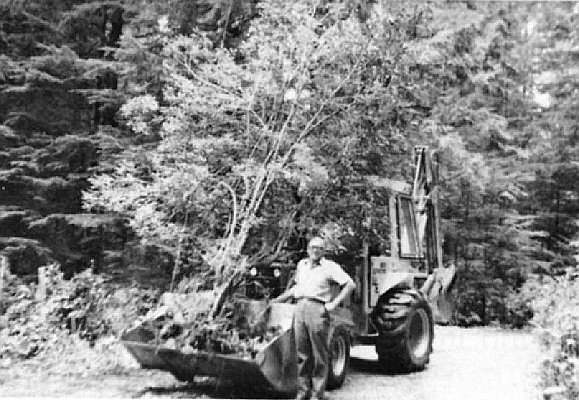
|
|
A fine specimen of
R. yunnanense
from seed
Photo by Rex Murfitt |
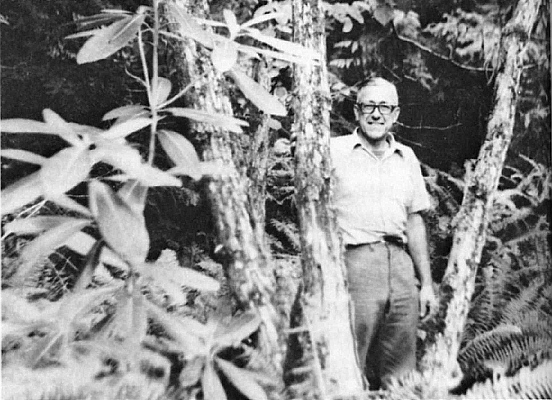
|
|
A seedling in the oldest part of the garden, name unknown
Photo by Rex Murfitt |
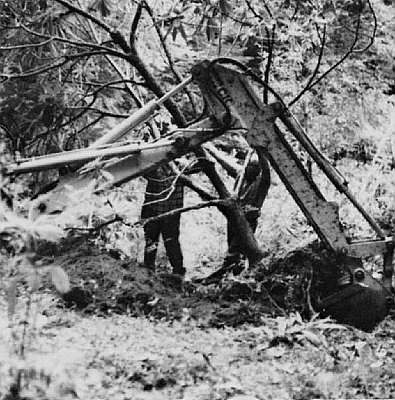
|
|
R. auriculatum
being prepared for moving to Victoria
Photo by Rex Murfitt |
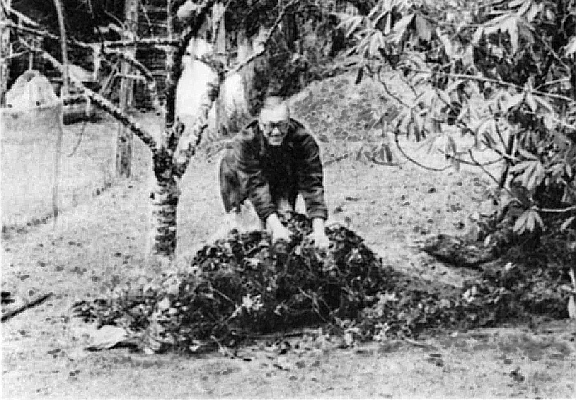
|
|
R. repens
"rolled" ready for loading
Photo by Rex Murfitt |
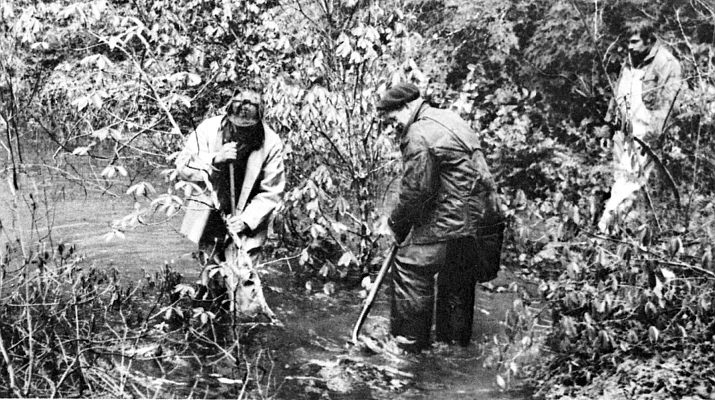
|
|
Digging
R. jucundum
in the floodwaters of the pond
Photo by Rex Murfitt |
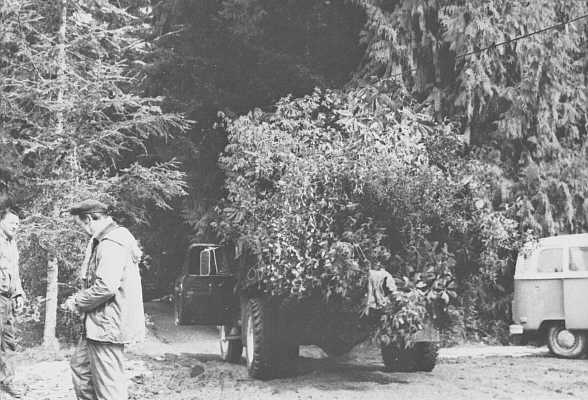
|
|
Rhododendrons laid like cordwood for the trip to Victoria
Photo by Rex Murfitt |
We decided to dig and transport only those plants we could manage by manpower alone, leaving the large plants until the fall, when arrangements could be scheduled. The actual digging started in late March, 1975, as early as the Cowichan climate allowed. Even then it snowed every night and morning for the six days we worked there. Rummaging around in the weeds covered with wet snow, as we located the smaller species, was most unpleasant to say the least. Several species of the glaucophyllum Series all had dozens of rooted layers and rambling main stems that took advantage of space where it was to be stolen. A straggling mat of R. hanceanum nanum , covered at least 12 square feet, beside it a similar sized R. prostratum languished beneath the great fortunei trees. Two incredible plants of R. forrestii var repens , some nine inches tall, each engulfed an area of sixty square feet. Both a solid mass of stems intermixed with snow-flattened cinnabarinum, gaultheria, Shortia, Epigaea and Schizocodon. The only practical way we could find to dig them up turned out to be similar to lifting sod from a lawn. We peeled them from the ground, rolling them up as we dug, teasing runners and rooted branches from the moss as we went. The finished product was two, long and very heavy, rolled 'carpets', both beyond our ability to lift and carry. We rolled them onto a sheet of corrugated tin and slid them out through the snow and mud.
Despite the discomfort caused by cold and wet, for it is very trying to write labels and tie-in branches when the hands are stiff with cold, the hand digging operation moved along very well. About 280 plants were lifted and shipped. Once safely heeled-in in the beds, watered and staked, we could concentrate on the major task of clearing and preparing the garden to house the bigger specimens that would follow in the fall. Again, the Cowichan weather was a concern to us, our spring experience told us it was nothing like our accustomed Victoria conditions. The summer of 1975 was hot and very dry, and it gave every indication of continuing right into the fall planting season. Two weeks of unexpected rain, towards the end of August, set the stage, a chance not to be missed. So hurried plans were made, a machine, the trucks and the men were all lined up and the move was on.
The actual digging of the large plants was done completely by backhoe, using the type with the extending boom. One man was detailed to direct the bucket in the close work around the roots, and to hold back branches to prevent breakage. Many plants were lifted in three movements, the first, to cut alongside the plant, about three feet or so from the stem. The stems were then pulled to one side and the bucket positioned squarely behind the trunk. Then it dug down and under the roots, drawing slowly forward, pulling all the major roots with it. Then, still gripping the root ball, the machine carried the plant to the assembly point. Very large specimens were dug in a more conventional manner, taking care to dig around the plant and free the root ball, lifting from the hole with the larger front bucket.
While the sandy, gravel nature of the soil was not conducive to forming good solid root balls, it did give freely without too much root breakage. Many specimens came out of the ground, to all purposes, bare rooted. Naturally, they showed distress as soon as the sun reached them and a man spent much of his time spraying them overhead and soaking the roots. It was reassuring to see the recovery overnight, the heavy dews held them up until mid-day, when the watering began again.
We employed twelve-yard, tandem gravel trucks to haul the plants as the road into the property forbade anything larger. Seven loads of plants were shipped in two days. Unloading the first truck was a nightmare of tangled roots and branches, time loss in handling them was high and damage was serious. The problem was solved on following loads by tying a rope to the trunk of the first plant into the bottom of the truck, the long, free end trailed out of the back of the box. When it came to unload, the free end was tied to a convenient tree, the dump box raised slightly, and the truck pulled slowly forward, the entire load was gently pulled from the box. It was very gratifying to see the massive bundles of rhododendrons sigh gently to the ground so easily, with virtually no breakage.
-- to be continued --
